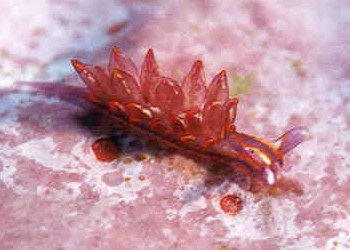
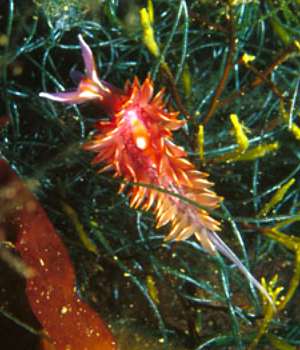
Hermaea variopicta
(Costa, 1869)
Order: SACOGLOSSA
Superfamily: LIMAPONTIOIDEA
Family: Hermaeidae
DISTRIBUTION
Mediterranean, Morocco, Atlantic coast of France and southwestern England.
PHOTO
Upper: Port de la Selva, Spain, Mediterranean Sea, Depth 12 m, Size 7 mm. September 2000. Photo: Jean Pierre Bielecki. Lower: Etang de Thau - France, Mediterranean. Depth: 8 m. Length: 30 mm. 5 March 2005. Mud covered with Enteromorpha and other algae. Photographer: Sylvie Grall.
Brightly coloured sacoglossan growing to approx 40 mm in length. It has a light purple body with streaks of dark purple. The head, rhinophores and dorsal surface of body have characteristic pattern of orange and white markings, including concentric rings of orange and purple on the pericardial hump. The cerata are light purple with a bright orange tip and the anterior and posterior edges of the cerata lined with white. There is a single digestive gland duct in the cerata. The cerata are able to inflate and deflate, so changing the general shape of the body quite quickly.
-
Costa, A. (1869). Appendice al saggio sui molluschi Aeolididae del golfo Napoli. Gen. Hermaeopsis. Annuario Museo di Zoologico della Universit di Napoli, 5: 46-49.
-
Gascoigne, T. 1976. The reproductive systems and classification of the Stiligeridae (Opisthobranchia: Sacoglossa). Journal of the Malacological Society of Australia, 3: 157-172.
-
Gascoigne, T. 1979. Observations on the anatomy of Hermaea variopicta (Opisthobranchia: Ascoglossa). Journal of Zoology, 187: 223-233
-
Jensen, K.R. 1996. Phylogenetic systematics and classification of the Sacoglossa (Mollusca, Gastropoda, Opisthobranchia). Philosophical Transactions of the Royal Society of London, B., 351: 91-122
-
Lemche, H. and Thompson, T. E. (1974) Three opisthobranch gastropods new to the British fauna. Proceedings of the Malacological Society of London, 41: 185-193.
-
Thompson, T. E. and Brown, G. H. (1976) British opisthobranch molluscs. Mollusca: Gastropoda, Synopses of the British fauna (new series), no 8. Linnean Society: London. 203 pp, 1 pl.
Rudman, W.B., 2005 (March 18) Hermaea variopicta (Costa, 1869). [In] Sea Slug Forum. Australian Museum, Sydney. Available from http://www.seaslugforum.net/find/hermvari
Related messages
Re: Hermaea variopicta, a rare species in France
September 3, 2007
From: Eric Pesme
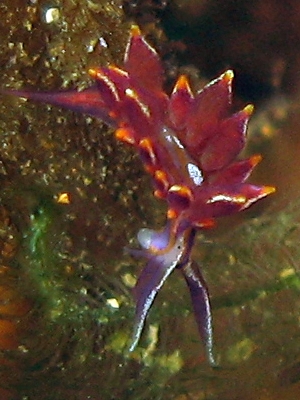
Concerning message #15517:
Hi Bill,
During a dive in the French Mediterranean spot "Le Chaouen", a big wreck close to Le Planier island in Marseille Bay, I saw this very little seaslug (between 3 and 5 mm approximately). It seems to be Hermaea variopicta, according to the factsheet of this species. Could you confirm ?
Locality: Le Chaouen, ile de Planier, Marseille, 20 m, France, Mediterranean, 21 July 2007, on a wreck. Length: 5 mm. Photographer: Eric Pesme.
Do you think the number of cerata is only growing with individual length ? Among the photos on the seaslug forum, the Atlantic ones seems to have more cerata than Mediterranean ones, but Mediterranean individuals represented are also smaller and there are only few individuals to compare...
I hope it will be interesting to improve distribution knowledge in Mediterranean.
Thank you for all.
Eric Pesme
eric_pesme@yahoo.fr
Pesme, E., 2007 (Sep 3) Re: Hermaea variopicta, a rare species in France. [Message in] Sea Slug Forum. Australian Museum, Sydney. Available from http://www.seaslugforum.net/find/20608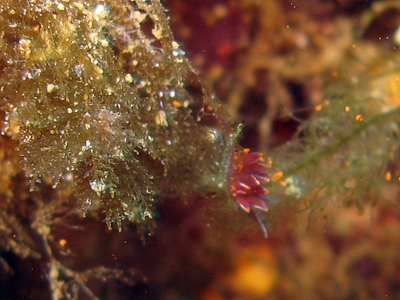
Dear Eric,
Yes this is Hermaea variopicta. Its colour pattern is very distinctive. The cerata in sacoglossans and aeolids do increase in number as the animal grows in size. We have few records of this species, so every new bit of information is valuable.
Best wishes,
Bill Rudman
Hermaea variopicta from NW Spain
March 9, 2007
From: Javier Santiago Caamaño
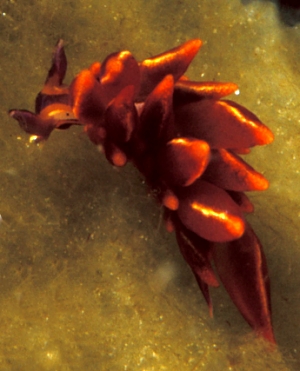
I photographed this nudibranch in Galicia, in the northwest Spain.
Locality: Ria de Muros, 7 metres, Galicia, NW Spain, Atlantic Ocean, August 2001, On a broken piece of laminarian alga. Length: 15 mm. Photographer: Javier Santiago Caamaño.
Can you help me to identify the species?
Thank you very much.
Javier Santiago Caamaño
javisan@edu.xunta.es
Caamaño, J.S., 2007 (Mar 9) Hermaea variopicta from NW Spain. [Message in] Sea Slug Forum. Australian Museum, Sydney. Available from http://www.seaslugforum.net/find/19629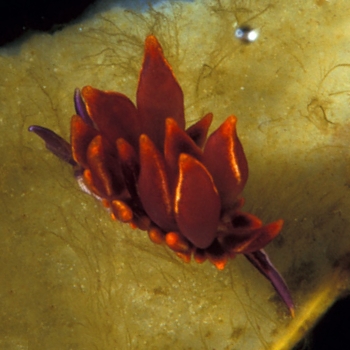
Dear Javier,
Although this looks like a carnivorous aeolid nudibranch, it is in fact the herbivorous sacoglossan sea slug, Hermaea variopicta. Have a look at the Fact Sheet and earlier messages for more information on this species.
Best wishes,
Bill Rudman
Re: Hermaea variopicta, a rare species in France
April 20, 2006
From: Cynthia Trowbridge
Concerning message #15517:
Dear Bill and Bernard,
It is great to see information about this species. After searching in great detail (even before Bernard's messages), I have found no published information on ovum or capsule size, larval type, etc. of this species. It may be in the type description (Costa, 1869) but I have not been able to locate that yet. If there were any way to get any additional information -- quantitative or qualitative -- that would be a major contribution. For example, the maximum reported body size seems to be 18 mm.... so already the 30 mm recorded size in the first message seems to be a new record!
Regarding the comment that the eggs were not deposited on the host algae, I have found this to be common for sacoglossan species that feed on filamentous algae. For example, some species place their egg masses on firm macroalgae or rocks in the same tidepool or area. This behavior makes sense, given that the slug's feeding activities often cause the filament distal to feeding damage to slough off in wave action.
Thank you so much for observations on this species! I have been looking for Hermaea spp. for years on rocky shores of Ireland, Isle of Wight (UK), and the Channel Islands. Hermaea bifida is rather common but H. variopicta is a great find.
Gratefully,
Cynthia
trowbric@yahoo.com
Trowbridge, C.D., 2006 (Apr 20) Re: Hermaea variopicta, a rare species in France. [Message in] Sea Slug Forum. Australian Museum, Sydney. Available from http://www.seaslugforum.net/find/16359Dear Cynthia,
Thanks for all the feedback. I guess it means you are either not in the field or are free from teaching for a while. I am glad the Forum is able to assist in ecological studies. The thousands of extra pairs of eyes who visit and participate in the Forum help to ensure that those 'rare occurrences' are no longer so rare.
Best wishes,
Bill Rudman
Hermaea variopicta - egg ribbons
March 29, 2006
From: Hervé Limouzin
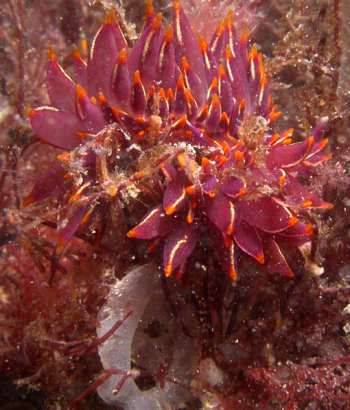
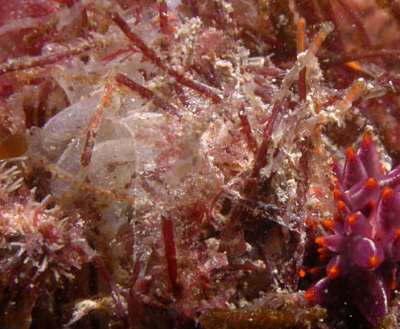
Dear Bernard,
Dear Bill,
I dived again at La Rance-Saint Malo [see message #15936], and I saw -again- numerous Hermaea variopicta. There were many couples on massive eggs masses like you can see in my photos. I took photos at 3 different place during the dive. I observed that algae near Hermaea are covered with a sort of translucent frosting. The egg ribbon's size was about 2-3 mm in diameter. I don't see spirals but I think that it is due to the type of algae on which the eggs are attached (there are no flat surfaces...) The color
is translucent white and the eggs are easy to see in the ribbon.
Concerning the algae, I ask for help from local experts and the 2 algae on which I saw Hermaea were Soleria chordalis and Plocamium cartilagineum (not Halurus equisetifolius).
Sincerely
Hervé Limouzin
billr@seaslugforum.net
Limouzin, H., 2006 (Mar 29) Hermaea variopicta - egg ribbons. [Message in] Sea Slug Forum. Australian Museum, Sydney. Available from http://www.seaslugforum.net/find/16192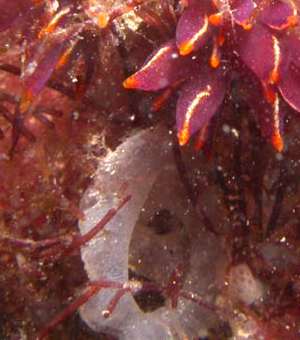
Dear Hervé,
I must say I was expecting an egg mass like this, but some species of Placida certainly lay white jelly-like masses like this, but in m experience they are attached on one side. As you say the type of algae aren't best for attaching an egg ribbon.
Thanks for keeping us informed. I am not sure if the egg ribbon of this species has been noted before
Best wishes,
Bill Rudman
Re: Hermaea variopicta - reproduction
February 24, 2006
From: Hervé Limouzin
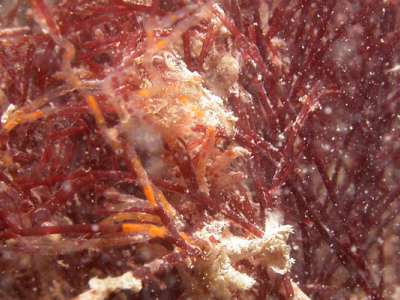
Concerning message #15935:
Hi Bernard,
Hi Bill,
When looking my pictures, I'm not sure that what I saw were eggs masses...
Unfortunately, I can't go to dive before next week (wednesday or tuesday...). Here's a picture, not very good, sorry...
About the algae I saw Hermaea variopicta on, there was two species: one was Halurus equisetifolius: on this species, I saw single animals. I haven't identified the second species yet, but on it, I saw single animals and couples.
On my next dive, I will take some algae to dry it and send Bernard for
identification. Thank you very much for your informations.
Hervé
limouzin.herve@tiscali.fr
Limouzin, H., 2006 (Feb 24) Re: Hermaea variopicta - reproduction. [Message in] Sea Slug Forum. Australian Museum, Sydney. Available from http://www.seaslugforum.net/find/15936Dear Hervé,
I would suspect the egg masses of this species would form a spiral. Have a look at the following messages for photos of sacoglossan egg masses: #9719; #9583; #4160; #12277; #7521.
Good luck with your search,
Bill Rudman
Re: Hermaea variopicta - reproduction
February 24, 2006
From: Bernard Picton
Concerning message #15915:
Hi Hervé,
Nice pictures - your animals are really well-coloured. I'd be really interested to know which alga or algae they were feeding on. I've only found this species on one or two occasions and it was eating Halurus equisetifolius. If you can't identify the alga you could press and dry it and I could check it for you.
http://www.cryptogamicbotany.com/lm_start.html gives details of pressing algae - they say fix first in Formalin but I don't do that, just dry it onto a sheet of good paper using something non-stick (nylon or disposable nappy liner) on top to stop it sticking to the blotting paper.
I'd be really interested to see photos of the egss as well. You seem to have a population explosion at that site at the moment, Opisthobranchs are like that - can be really rare for years, then suddenly you find a place where they are really abundant. Sometimes they will be at that place for several years, or they may all move on to another food source elsewhere.
Bernard
billr@seaslugforum.net
Picton, B.E., 2006 (Feb 24) Re: Hermaea variopicta - reproduction. [Message in] Sea Slug Forum. Australian Museum, Sydney. Available from http://www.seaslugforum.net/find/15935Hermaea variopicta - reproduction
February 22, 2006
From: Hervé Limouzin
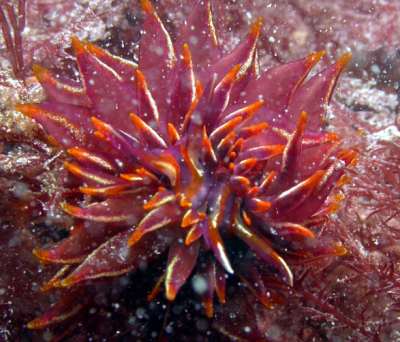
Dear Bill,
After my first observation of this species, in December 2005, [#15517] I recently got back to dive at La Rance (north coast of France, Near St Malo)
This time, we saw many couples of the sacoglossan Hermaea variopicta.
Near by there was some eggs ribbons which I thought might be theirs. They were pale translucent with orange colored eggs - is that right ?
Locality: Jouvente, La Rance, 10 metres, France - Atlantic coast (la Manche), 18 February 2006. Length: 30 mm. Photographer: Hervé Limouzin
Here are photos of a couple of animals.
Best regards.
Hervé Limouzin
limouz1@free.fr
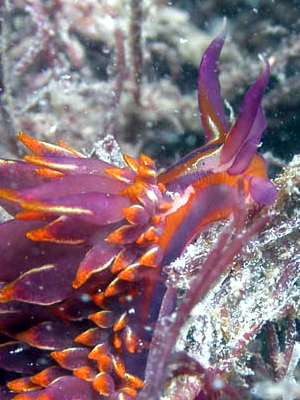
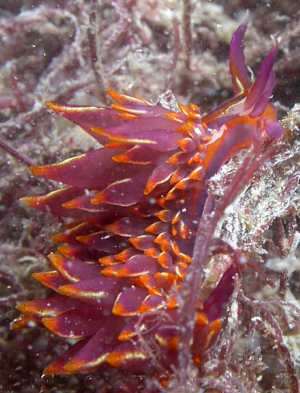
Dear Hervé,
I am pretty sure this species has bright orange coloured eggs. Did you by chance take a photo of the egg mass?
Best wishes,
Bill Rudman
Hermaea variopicta, a rare species in France
January 11, 2006
From: Hervé Limouzin
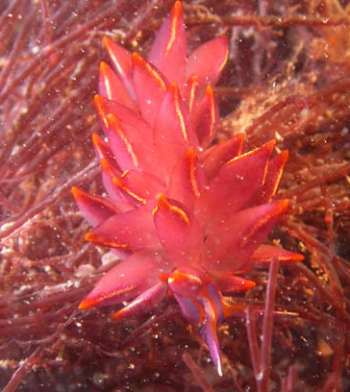
Hi Bill,
During a dive in La Rance on the English Channel [La Manche] coast of France, I saw this superb sea slug.
Locality: La Rance, St Malo, France. Atlantic coast.: Depth: 10 m. Length: 30 mm. 18 December 2005. Photographer: Hervé Limouzin
I first thought it was a Eubranchus but Bernard Picton indicated to me that it's a rare sacoglossan opistobranch : Hermaea variopicta.
According to your web site, it looks the same. Could you confirm ?
Thank you
Hervé Limouzin
limouzin.herve@tiscali.fr
Limouzin, H., 2006 (Jan 11) Hermaea variopicta, a rare species in France. [Message in] Sea Slug Forum. Australian Museum, Sydney. Available from http://www.seaslugforum.net/find/15517Dear Hervé,
I certainly agree with Bernard's identification, his knowledge of the Nth Atlantic fauna is far superior to mine.
Best wishes,
Bill Rudman
Hermaea variopicta from the French Mediterranean
March 18, 2005
From: Sylvie Grall
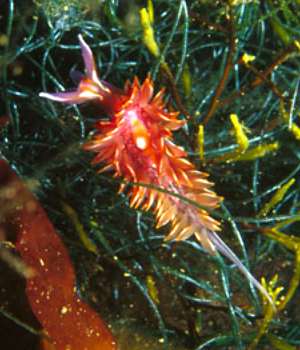
Thank you very much for this website, very useful for Id on my photos.
I have doubts on this one. I think the genus is Aplysiopsis but I couldn't find the species. Could it be A. enteromorphae? The slug seemed to be able to inflate its ceratas when disturbed. The water was cold : 7°C. There were a lot of Hermaea bifida around ready to lay eggs.
Locality: under oyster lines, within Enteromorpha. Etang de Thau - France,
Mediterranean. Depth: 8 m. Length: 30 mm. 5 th March 2005. Mud covered with Enteromorpha and other algae. Photographer: Sylvie Grall
In Thau we find many cosmopolitan species. This is the first time I see this one. I couldn't find any other specimen on the dive.
Can you help?
Thank you very much.
Sylvie Grall
SGRALL@compuserve.com
Grall, S., 2005 (Mar 18) Hermaea variopicta from the French Mediterranean. [Message in] Sea Slug Forum. Australian Museum, Sydney. Available from http://www.seaslugforum.net/find/13348Dear Sylvie,
This is Hermaea variopicta. Some of these aeolid-looking sacoglossans are difficult to tell apart and so your suggestion that this might be a species of Aplysiopsis was not far off the mark. Hermaea variopicta is one of those rare sacoglossans which are brightly coloured. Most sacoglossans are remarkably well camouflaged to match the greens and browns of the algae they feed on.
It is nice to get a photo of an adult animal. It has made me prepare a proper Fact Sheet for this species.
Best wishes,
Bill Rudman
Re: Hermaeopsis
February 16, 2001
From: Kathe R. Jensen
Dear Bill and Jean-Pierre,
With our present knowledge about the anatomy of Hermaea and Hermaeopsis, the latter genus seems to be superfluous, and H. variopicta can be included in the genus Hermaea. Whether future phylogenetic analysis of more species will show something different we will have to wait and see.
The genus Hermaea is in the family Hermaeidae, whereas the genus Placida - to which many species originally described as Hermaea, have been transferred - belongs to the family Limapontiidae (previously called Stiligeridae). This may sound confusing, but is actually based on some fundamental differences in the reproductive system, which is diaulic in the Hermaeidae and triaulic or pseudodiaulic (in species with hypodermic impregnation into seminal receptacle) in the Limapontiidae. There are other anatomical differences as well. The Hermaeidae consists of the genera Hermaea (incl. Hermaeopsis) and Aplysiopsis, so it is a rather small family. However, I think most of the confusion arises because so many species described as Hermaea actually belong in the genus Placida.
References:
• Gascoigne, T. 1976. The reproductive systems and classification of the Stiligeridae (Opisthobranchia: Sacoglossa). Journal of the Malacological Society of Australia, 3: 157-172.
• Gascoigne, T. 1979. Observations on the anatomy of Hermaea variopicta Opisthobranchia: Ascoglossa). Journal of Zoology, 187: 223-233.
• Jensen, K.R. 1996. Phylogenetic systematics and classification of the Sacoglossa (Mollusca, Gastropoda, Opisthobranchia). Philosophical Transactions of the Royal Society of London, B., 351: 91-122.
Regards,
Kathe
jensen@ait.ac.th
Jensen, K.R., 2001 (Feb 16) Re: Hermaeopsis. [Message in] Sea Slug Forum. Australian Museum, Sydney. Available from http://www.seaslugforum.net/find/3812Thanks Kathe,
My biggest problem was I thought the Limapontiidae and Hermaeidae had been merged. Hopefully I have sorted out the ones on the Forum now.
Cheers,
Bill Rudman
Re: Hermaeopsis
February 14, 2001
From: Jean-Pierre Bielecki
Dear Bill
Thank you for your quick answer. I follow with interest your fantastic work on the Sea Slug Forum, and I have a question about the two Sacoglossan of my last mail. In the French web site : CLEMAM (www.mnhn.fr), Hermaeopsis variopicta is named Hermaea variopicta, same genus as Hermaea bifida. And also in this web site they belong to the Hermaeidae family. What do you think about this (new?) classification ?
Best regards.
Jean-Pierre Bielecki
bielecki.jeanpierre@free.fr
Bielecki, J-P, 2001 (Feb 14) Re: Hermaeopsis. [Message in] Sea Slug Forum. Australian Museum, Sydney. Available from http://www.seaslugforum.net/find/3790Dear Jean-Pierre,
I'll ask Kathie Jensen to clarify these two points. Concerning the Family. The higher taxonomy of the Sacoglossans appears to be in an exciting, if confusing , time of change. In recent years we have had many different studies on the phylogenetic relationships within the group. While this is very interesting and should be encouraged, it does mean that people in charge of lists of names sometimes find it difficult to keep up. My impression was that Hermaea was now considered to be part of the Limapontiidae, but I could be wrong.
Best wishes,
Bill Rudman
Hermaeopsis variopicta from Spain
February 7, 2001
From: Jean Pierre Bielecki

Dear Bill
Could you please identify this animal for me.
It was found in the Mediterranean Sea (September 2000, dive site: Port de la Selva, Spain, Depth 12m, Size 7mm.
Best wishes
Jean Pierre
bielecki.jeanpierre@free.fr
Bielecki, J.P., 2001 (Feb 7) Hermaeopsis variopicta from Spain. [Message in] Sea Slug Forum. Australian Museum, Sydney. Available from http://www.seaslugforum.net/find/3723Dear Jean Pierre,
This is another herbivorous sacoglossan sea slug. Although I have never seen it myself I am pretty sure from its brillaint colour pattern that it is Hermaeopsis variopicta.
Best wishes
Bill Rudman
